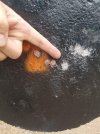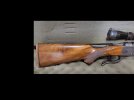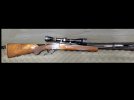.300 Dakota
Well-Known Member
So with the assistance of the folks at Manson Precision today, I re-invented the wheel. Many would argue that the .257 Weatherby is a tack driver and suitable for running the 133 grain Berger Elite hunting bullet given the appropriate twist. In my experience, it has been quite finicky, due to the excessive freebore, not allowing one to reach the lands, and the proposition of rolling the dice in hopes that what was produced would love the long Berger offering wasn't appealing. Eager to make a high-performance round with low recoil and having another half dozen projects currently running, I gave quite a bit of thought to a design. I could not afford at the time of this writing to buy another aftermarket action with all the trimmings and pay to have the Gunsmith Fairy whack the pile with his golden hammer and turn it into a long range tack-driver. I prefer to neck up, not down. The count of the number of specialty dies/tools and hours needed for the latter is high if you want a nice, straight case to load. Unfortunately, I couldn't find anything suitable with a magnum case head meant for a long action to neck up and remain under 30 caliber. (I have a fully blue printed and sleeved Remington 700 action available with all the internals replaced, oversized and ground lug and TriggerTeck Special 2-stage trigger set at 8 and 12oz.) To complicate matters, the .277 and .257 cal bores are only available in 1:10 twist, if at all, without special ordering. I was all set to give in to the necking down process and decrease a .308 Norma Mag to 7mm. It is shorter than the .300 Win case, which would give better magazine well clearance with the longer 195gr EOLs. I have 120 Norma cases onhand, and I figured I better get more. They were available a year ago, but no longer. No sense in building a wildcat that you may bever be able to get brass for ever! I have plenty of 6.5x300 Wby brass, but the case is too long and would need to be run in a longer aftermarket action. The 300 PRC was a strong contender for a wildcat. A 7/300 PRC wasn't a bad idea, and it's been done numerous times, so there might be some data. I kept that clicker issue running through my mind, though.
Finally I decided to look to see what was available as far as brass. I found a cache of .264 Win Mag, but realized necking up would be pointless unless I wanted to shoot only up to 150 grain bullets in a .27 bore. And besides, the neck is way too short on the 264 for anything larger and longer. Necking down however, was an intriguing proposition. The neck length is perfect for the quarterbore; better suited than for the .264, in fact. The 800lb gorilla in the room was the 257 Weatherby Magnum. It holds 80.4 grains of water and operates at 62, 500psi max avg. pressure with .378" of freebore. So much freebore, that the caryridge is notoriously finicky, and I personally have not been able to find a tack-driving load in a couple of iterations of the cartridge - admittedly neither being a Mark V. I considered the price difference of brass - I bought 50 264 cases for only about 25% more than I would have paid for 20 257 Wby cases. Also I thought about rapid cycling in a long cartridge with double radiused shoulder vs one with a 25-degree shoulder in a push feed action. It doesn't seem to bother the Mark Vs or the Howas so chambered, but 1) The original Weatherby action was a Mauser CRF type, if I'm not mistaken, produced in Germany (perhaps they have specially designed feed ramps that a 700 might not have?), and 2) My cartridge will have a much longer pointy bullet nose protruding out a good bit. This still may be a single feed proposition when all is said and done. The .264 holds 80.7 grains of water, but has little freebore by comparison.
So it was decided, and the moment was seized. A call to Manson Precision yielded the production of a reamer for the .250 MDC. The numerical bore diameter is used to help distinguish it from others in the quarterbore genre, as only the .250 Savage carries this designation, to my knowledge, while multiple cartridges use both .25 and .257. The M is the Roman Numeral translating from Latin to "mille," which is an adjective representing a quantity of 1000. This is the point in yards where the bullet will fall below the 1000 ft-lbs of energy threshold that has been recognized for years as the minimum level of energy needed to cleanly harvest deer. So it can be viewed as both max range for deer and minimum energy range. The DC stands for Deer Cartridge. I have a small series of DCs running currently. Others are based on short action, non-magnum rounds.
The 264 Win operates at a slightly higher max avg. pressure than the .257 Wby (64,000). Freebore of the new design is, you guessed it, 1/4 (.250"). This is both significantly less than the .257 Wby for better consistent accuracy, and significantly more than the .264 Win parent chamber to allow higher velocity at lower pressures.
I have ordered enough norma brass and Berger 133gr Elite Hunters (under $60/100 compared to larger caliber high BC bullets) to last, and will have the tooling by mid-June. A smith is lined up to switch barrels on my currently unused .338 Edge, and a 28" Brux barrel blank is on the way in 7.5 Twist and will finish at 27". I will swap the current HS Precision stock for an AG Composites. Many will cringe when I state the contour of the barrel is only #4, but I DETEST weight. That's why the 1/2 MOA Edge is being rebuilt. It will make the rifle more finicky, most likely, but I am confident, since I've never had a Brux barrel fail to produce at least 1/2" accuracy. It should be ready by August. I cannot argue that all one would need to to have an equally good round is resuce freebore on the available Weatherby offering by about 1/3, but I can argue the price of brass. Either way, new tooling and a new rifle would need to be built.
Finally I decided to look to see what was available as far as brass. I found a cache of .264 Win Mag, but realized necking up would be pointless unless I wanted to shoot only up to 150 grain bullets in a .27 bore. And besides, the neck is way too short on the 264 for anything larger and longer. Necking down however, was an intriguing proposition. The neck length is perfect for the quarterbore; better suited than for the .264, in fact. The 800lb gorilla in the room was the 257 Weatherby Magnum. It holds 80.4 grains of water and operates at 62, 500psi max avg. pressure with .378" of freebore. So much freebore, that the caryridge is notoriously finicky, and I personally have not been able to find a tack-driving load in a couple of iterations of the cartridge - admittedly neither being a Mark V. I considered the price difference of brass - I bought 50 264 cases for only about 25% more than I would have paid for 20 257 Wby cases. Also I thought about rapid cycling in a long cartridge with double radiused shoulder vs one with a 25-degree shoulder in a push feed action. It doesn't seem to bother the Mark Vs or the Howas so chambered, but 1) The original Weatherby action was a Mauser CRF type, if I'm not mistaken, produced in Germany (perhaps they have specially designed feed ramps that a 700 might not have?), and 2) My cartridge will have a much longer pointy bullet nose protruding out a good bit. This still may be a single feed proposition when all is said and done. The .264 holds 80.7 grains of water, but has little freebore by comparison.
So it was decided, and the moment was seized. A call to Manson Precision yielded the production of a reamer for the .250 MDC. The numerical bore diameter is used to help distinguish it from others in the quarterbore genre, as only the .250 Savage carries this designation, to my knowledge, while multiple cartridges use both .25 and .257. The M is the Roman Numeral translating from Latin to "mille," which is an adjective representing a quantity of 1000. This is the point in yards where the bullet will fall below the 1000 ft-lbs of energy threshold that has been recognized for years as the minimum level of energy needed to cleanly harvest deer. So it can be viewed as both max range for deer and minimum energy range. The DC stands for Deer Cartridge. I have a small series of DCs running currently. Others are based on short action, non-magnum rounds.
The 264 Win operates at a slightly higher max avg. pressure than the .257 Wby (64,000). Freebore of the new design is, you guessed it, 1/4 (.250"). This is both significantly less than the .257 Wby for better consistent accuracy, and significantly more than the .264 Win parent chamber to allow higher velocity at lower pressures.
I have ordered enough norma brass and Berger 133gr Elite Hunters (under $60/100 compared to larger caliber high BC bullets) to last, and will have the tooling by mid-June. A smith is lined up to switch barrels on my currently unused .338 Edge, and a 28" Brux barrel blank is on the way in 7.5 Twist and will finish at 27". I will swap the current HS Precision stock for an AG Composites. Many will cringe when I state the contour of the barrel is only #4, but I DETEST weight. That's why the 1/2 MOA Edge is being rebuilt. It will make the rifle more finicky, most likely, but I am confident, since I've never had a Brux barrel fail to produce at least 1/2" accuracy. It should be ready by August. I cannot argue that all one would need to to have an equally good round is resuce freebore on the available Weatherby offering by about 1/3, but I can argue the price of brass. Either way, new tooling and a new rifle would need to be built.



